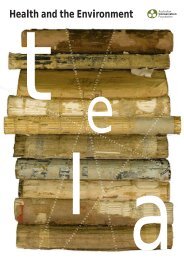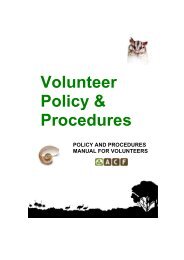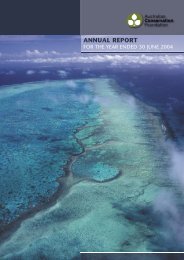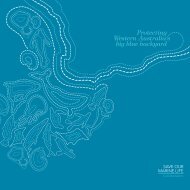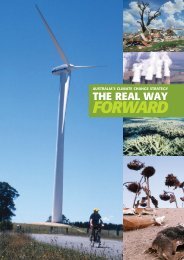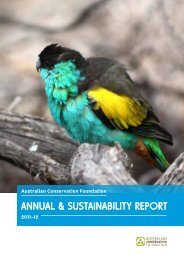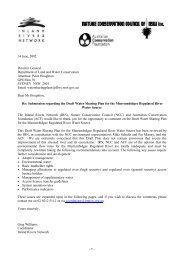Kimberley Appropriate Economics Interim Report - Australian ...
Kimberley Appropriate Economics Interim Report - Australian ...
Kimberley Appropriate Economics Interim Report - Australian ...
Create successful ePaper yourself
Turn your PDF publications into a flip-book with our unique Google optimized e-Paper software.
Ord: Case study for inappropriate<br />
development and poor planning<br />
Tanya Vernes (WWF-Australia) & Tamsin Kilner<br />
50<br />
Introduction<br />
The 650km long Ord River is one of the major river systems of Western Australia, stretching from it’s<br />
source north-west of Halls Creek to empty into the Cambridge Gulf near Wyndham. The river has been<br />
dammed twice; in 1961 the Kununurra Diversion Dam (KDD) was started, creating Lake Kununurra,<br />
followed by the Ord River Dam (ORD) in 1973 forming Lake Argyle. The aim of the dams was to<br />
provide water for irrigated agriculture within the Ord River Irrigation Area (ORIA) which currently<br />
covers around 15,000ha with future plans to expand to 65,000ha under Stage II. The resulting large<br />
inland water bodies are used for recreation, tourist boat charter, aquaculture and commercial fishing.<br />
From an economic and social point of view, the river is a significant feature and attraction, however<br />
many cultural values have been degraded since damming, including loss of heritage sites and disconnection<br />
to country.<br />
The Ord dam and associated agriculture are often advertised as a successful model for economic<br />
development. However, the validity of the financial rationale supporting construction of the Ord River<br />
Dam has been seriously questioned since its inception and in the 30 or so years it has been in operation,<br />
the dam has been heavily subsidised. Further, the decision to dam the Ord was based on poor science<br />
and lacking any ecological investigations or regard for Aboriginal custodians. As a result, there are<br />
serious environmental and social repercussions. Mistakes of the past, made outside of a sustainability<br />
assessment, with poor planning and lacking consultation, are now weighted on the current generations<br />
to solve.<br />
The purpose of the presentation is to give a perspective on the changes that have occurred since<br />
damming and their impacts on local Aboriginal people and the environment. Social implications are<br />
discussed, together with a brief history of how the decision to dam was taken, this draws heavily upon an<br />
earlier review by Graham-Taylor (1982). The cultural consequences of construction are then described,<br />
followed by the environmental effects of damming the river. The final section of the paper is concerned<br />
with the economic validity of the project as a whole. In order to learn from past mistakes a critique of<br />
the sustainability of the Ord Stage 1 will be given, highlighting issues for consideration prior to further<br />
development. The Ord River is an example of a valuable river system with diverse benefits to many<br />
people, and future planning decisions will impact directly and indirectly on a number of systems and<br />
values.<br />
1. Social<br />
The decision to dam the Ord was influenced by the political climate of the time, most notably a<br />
struggle for control of the north between the State and the Commonwealth governments (Graham-<br />
Taylor 1982). In addition, there existed a fear of invasion from Asia and there was much debate<br />
in parliament and in the press to develop measures for protection from the “thousand millions<br />
of coloured people adjacent to West <strong>Australian</strong> shores” (Graham-Taylor 1982). Populating the<br />
landscape (with settlers) could provide some protection and allay these safety concerns in part.<br />
Early surveys of the Ord River valley showed agricultural potential and began the dream of opening<br />
up the “unexploited tropical north” (Graham-Taylor 1982). Alexander Forrest’s exploration report<br />
of the Ord and Fitzroy valleys in the late 1870s sparked an interest in these areas for the pastoral<br />
industry and soon after the first enterprises began (Graham-Taylor 1982).<br />
In 1926 the Commonwealth government offered to assume responsibility of the north-west (north<br />
of the 26th parallel) but the Western <strong>Australian</strong> government did not accept. Having rejected the<br />
Commonwealth’s offer the WA government was under pressure to formulate a policy for the



